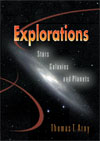 |  Explorations: Stars, Galaxies, and Planets Thomas Arny,
University of Massachusetts
Feature Summary- Packaged FREE with the Arny text is a NEW Interactive CD-ROM AND a great new internet tool -PowerWeb!
- PowerWeb! Harness the assets of the Web to keep your course current with PowerWeb! This online resource provides high quality, peer-reviewed content including up-to-date articles from leading periodicals and journals, current news, weekly updates with assessment, interactive exercises, Web research guide, study tips, and much more! Free with the new textbook!
The Astronomy Essential Study Partner CD-ROM offers students even more study tools and opportunities. The new CD-ROM will have guest essays, a constellation quiz, over 90 animations, images, links to astronomy websites, and much more.
- Comprehensive New Online Learning Center: This book specific web site gives instructors the tools they need, and provides study aids and enrichment for students. Instructors will have access to sample syllabi and lecture outlines. The web site will also include animations, hundreds of images, chapter summaries and key terms, web links, scorable practice quizzes, interactive tutorials, and much more.
- NetTutor! NetTutor is a revolutionary new web-based learning environment for the live dissemination of mathematical content. NetTutor offers your students live, personalized tutoring via the internet. Using NetTutor’s powerful WWWhiteboard software, students can communicate directly with a tutor--or if a tutor is not available, students can post a question and receive prompt feedback from an expert in their subject. The WWWhiteboard allows students and tutors to use proper mathematical notation as well as other highlighting features--truly making this a unique learning experience. Students may also post questions and receive a reply within 24 hours. Visiting the Message Center allows students to discuss difficult concepts among themselves, while the Archive Center provides a browseable list of questions and answers maintained by the subject tutor. NetTutor is FREE with Arny: EXPLORATIONS: Stars, Galaxies and Planets, an invaluable aid for all students; the study partner who always has the answer.
- Latest Scientific Information included! New discoveries and recent advancements in the field as well as new space images have bene added to this new text.
- Accessible writing style that allows coverage of technically complex ideas without confusing students. Tom Arny gives the students a reason to read every sentence.
- "Re-modeling" Sidebar applications. These boxes deal with the dynamic nature of scientific models, explaining how new technologies and information lead to the evolution and refinement of our theories.
- "Observational Activities": Many additional activities are included that students can try at home or in class. These are scattered throughout the text.
- Analogy Sketches are included in the margins.
- Customize this book through Primis Online! This title is planned to be a part of the Primis Online Database: www.mhhe.com/primis/online.
- An icon was placed next top key topics throughout the text to show where there are corresponding animations and interactive exercises on the accompanying CD-ROM. Along with the placement of the icon, there is a description of each animation.
- Reorganization of topics. Section on seasons from Chapter 4 to Chapter 1. Section 6.5 was integrated into Chapter 1. Chapter 5 moved to after Chapter 3.
- "Introduction" chapter changed to "Preview" to give a better orientation to astronomy.
- Latest scientific information included! New discoveries and recent advancements in the field as well as new space images have been added to this new edition. New information on: migration of the giant planets within the Solar Nebula; the shape of planetary nebulas; evidence from the cosmic microwave background that our Universe is flat; evidence for "recent" water flows on Mars; hypotheses for why Earth and Venus have such different surfaces; and the discovery of numerous brown dwarfs and low-temperature stars.
|
|



 2002 McGraw-Hill Higher Education
2002 McGraw-Hill Higher Education

 2002 McGraw-Hill Higher Education
2002 McGraw-Hill Higher Education